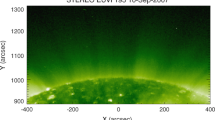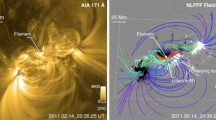Abstract
Observations of the outer solar corona obtained by the High Altitude Observatory's coronagraph aboard Skylab reveal the presence of dark, ray-like structures in the corona. A systematic identification of these voids, which exist for periods of about 24 hr, is presented and their existence as a coronal phenomenon, as opposed to a subtle photographic effect, verified. Photometric analysis indicates that these features represent reductions in the coronal radiance on the order of 5% - or about 2–3 × 10−10 B ⊙ at 3 R ⊙. The use of a previously determined model of the electron component of the corona permits specification of the electron density in the voids over the range 2.5–4.5 R ⊙. In spite of the inevitable uncertainties regarding their longitudinal extent, we estimate that their electron density is comparable to, or less than, that in coronal holes at similar heights. Projection of the phenomena onto synoptic surface maps indicates a close relationship with filaments and neutral lines; a potentially significant temporal correlation between the void formation and that of the underlying prominence is noted. The spatial and temporal resolution of the data set places stringent restrictions on any model which may be used to infer the physical processes of formation or decay of voids; several possibilities are suggested which involve either changes in the coronal base temperature or the magnetic flux.
Similar content being viewed by others
References
Crifo-Magnant, F. and Picat, J.-P.: 1980, Astron. Astrophys. 88, 97.
MacQueen, R. M., Eddy, J. A., Gosling, J. T., Hildner, E., Munro, R. H., Newkirk, G. A., Poland, A. I., and Ross, C. L.: 1974a, Astrophys. J. 187, L85.
MacQueen, R. M., Gosling, J. T., Hildner, E., Munro, R. H., Poland, A. I., and Ross, C. L.: 1974b, Proc. Photo. Opt. Eng. 44, 207.
Maltby, P.: 1978, in E. Jensen, P. Maltby, and F. Q. Orrall (eds.), ‘Physics of Solar Prominences’, IAU Colloq. 44, 344.
McIntosh, P. S.: 1979, Annotated Atlas of Hα Synoptic Charts, World Data Center A for Solar-Terrestrial Physics, Report UAG-70.
Munro, R. H. and Jackson, B. V.: 1977, Astrophys. J. 213, 874.
Poland, A. I., Gosling, J. T., MacQueen, R. M., and Munro, R. H.: 1977, Appl. Opt. 16, 926.
Saito, K. and Hyder, C. L.: 1968, Solar Phys. 5, 61.
Saito, K. and Tandberg-Hanssen, E.: 1973, Solar Phys. 31, 105.
Saito, K., Poland, A. I., and Munro, R. H.: 1977, Solar Phys. 55, 121.
Spitzer, L.: 1962, Physics of Fully Ionized Gases, Wiley, New York.
Tandberg-Hanssen, E.: 1974, Solar Prominences, D. Reidel Publ. Co., Dordrecht, Holland.
Author information
Authors and Affiliations
Additional information
The National Center for Atmospheric Research is sponsored by the National Science Foundation.
Rights and permissions
About this article
Cite this article
MacQueen, R.M., Sime, D.G. & Picat, JP. The properties of coronal voids. Sol Phys 83, 103–114 (1983). https://doi.org/10.1007/BF00148245
Received:
Revised:
Issue Date:
DOI: https://doi.org/10.1007/BF00148245




